6 Ways To Clean Your Microwave At Home Quickly
Microwave ovens are found in almost every kitchen and in many offices. With this small appliance, you can not only quickly warm up lunch or defrost food, but also prepare full-fledged dishes. Like any kitchen appliances, a microwave has the property of becoming dirty, no matter how carefully it is handled. Therefore, the question often arises, how to wash a microwave at home quickly and without much effort. In our article you will find 6 effective wayshow to get rid of traces of fat and burnt spots, eliminate unpleasant odors and easily keep the oven clean.
Preparing the microwave for cleaning
Those who have already repeatedly cleaned their stove, especially if the surface of its inner walls have already been covered with a noticeable greasy coating, can confirm that this process is quite time-consuming. 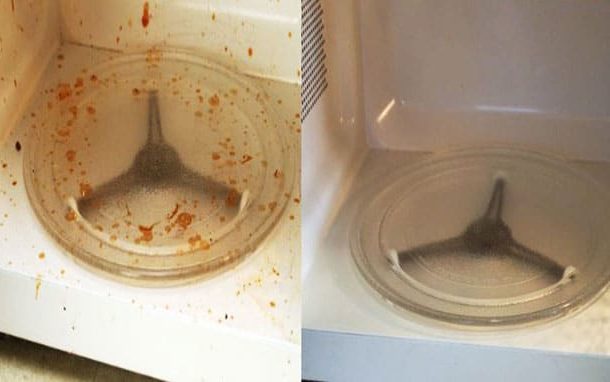 In addition, it is inconvenient, because the inner walls often have irregularities and mesh sections. there is a series of recommendations which will make the process more convenient and safe:
In addition, it is inconvenient, because the inner walls often have irregularities and mesh sections. there is a series of recommendations which will make the process more convenient and safe:
- Before starting to wash the microwave in any way, be sure to disconnect the device from the power supply;
- Take out all movable removable parts of the structure. Namely, a glass dish and a plastic insert, which is located under it;

- If the dish is covered with a layer of fat or there are burnt spots on it, put the dish in a bowl, pour a little dish detergent and pour boiling water. Let the glass surface “dissolve” while you are engaged in cleaning the inner walls;
- Do not try to disassemble the device or remove other spare parts on your own in order to facilitate access to problem areas, if this instruction is not provided for by the operating and maintenance instructions for the device;
- Do not disregard the internal seams. Crumbs often fall into them, fluid flows, which causes the appearance of unpleasant odors. It is possible to clean hard-to-reach places well with a soft toothbrush;

- Try to use the minimum amount of water and squeeze sponges or a napkin well to avoid getting excessive water on sensitive structural elements;
- Never use hard sponges, metal scrapers or abrasive detergents to remove stubborn dirt. The fact is that the internal walls of the microwave oven are covered with a very thin layer of a special reflective microwave composition, due to which heating occurs. If the integrity of the coating is damaged, the device may fail;
- Before applying the main method of cleaning the inner surface, it is always recommended to pre-soak, soften the layer of grease or any other contamination. To do this, type in a basin or a small bucket of warm water. Add a little dishwashing detergent and foam. Moisten the sponge, wring it out thoroughly and go over all the necessary surfaces. Now you can proceed to the main stage;

- After the cleaning process is completed, be sure to thoroughly wipe the inside of the surface with a dry soft cloth and leave the door open until the moisture has completely evaporated.Only then can we proceed with the further use of the microwave oven.
Method number 1 - steam cleaning
If stains fat or burning did not have time to get old, they can be taken in the simplest and fastest way - using steam exposure.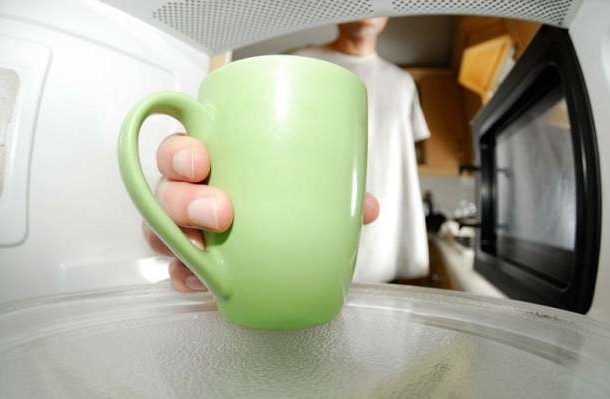
- Put in the oven a small container, specially designed for use in microwave ovens, and fill it with water 2/3;
- Turn on the stove to maximum temperature and set the timer for such a number of minutes that the water has time to boil and boil for 3-5 minutes;
- During boiling, hot steam will be released, under the influence of which simple contaminants easily “move away” from the surface;
- When the oven turns off, do not rush to open the door. Wait 5 minutes;
- Dampen a soft sponge in warm, clean water and wipe the walls thoroughly. Then wipe the oven with a dry cloth and leave the door open.
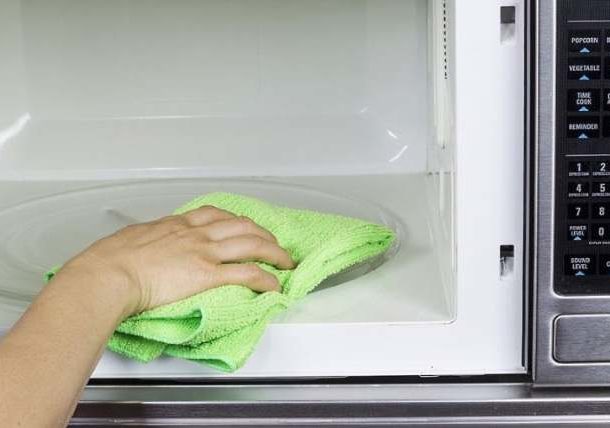 Note, Some modern microwave ovens already have built-in steam cleaning. All you need to do is pour water into a special cavity at the bottom or into a container (read the operating instructions) and start the corresponding mode. If you use this cleaning method after each intensive use of the device, it will be much easier to keep it clean.
Note, Some modern microwave ovens already have built-in steam cleaning. All you need to do is pour water into a special cavity at the bottom or into a container (read the operating instructions) and start the corresponding mode. If you use this cleaning method after each intensive use of the device, it will be much easier to keep it clean.
Method number 2 - cleaning soda
If degree of pollution can be described as average In addition, the characteristic musty smell use a method based on the use of baking soda.
- Put in the oven a wide and deep bowl filled with warm water for 2/3 of the volume;
- Add to the water 3 tbsp. tablespoons of ordinary baking soda and mix gently until the crystals are completely dissolved;
- Turn on the microwave at maximum power for 5-10 minutes;
- After turning off, leave the door closed for another 3-5 minutes;
- Open the door, take out a bowl of soda solution and thoroughly wipe the walls with a dry cloth;
- If you see that some of the impurities are not completely amenable, rub them with a cloth soaked in the same soda solution;
- If necessary, the procedure can be repeated again;
- At the end of the wall they are wiped dry and the door is left open.
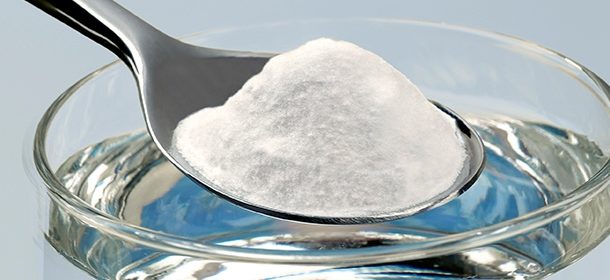 This method is quite effective, since during boiling water on the walls of the device not just condensate settles, but soda concentrate. It effectively dissolves body fat and disinfects the surface, which eliminates the unpleasant odor. The main thing is to completely dissolve the soda, so that in case of rubbing the walls with a solution, there are no abrasive particles left in it.
This method is quite effective, since during boiling water on the walls of the device not just condensate settles, but soda concentrate. It effectively dissolves body fat and disinfects the surface, which eliminates the unpleasant odor. The main thing is to completely dissolve the soda, so that in case of rubbing the walls with a solution, there are no abrasive particles left in it.
Method number 3 - vinegar or citric acid
This method is great deal as with fat spotsand so with burnt tracks.  If you often use your appliance to defrost foods such as meat, poultry or fish, you probably noticed that a characteristic bad smell. In the fight against such a persistent "aroma" soda can be powerless, so it is better to use vinegar or citric acid. Be sure to open the windows for ventilation, as the process will be accompanied by a pungent odor.
If you often use your appliance to defrost foods such as meat, poultry or fish, you probably noticed that a characteristic bad smell. In the fight against such a persistent "aroma" soda can be powerless, so it is better to use vinegar or citric acid. Be sure to open the windows for ventilation, as the process will be accompanied by a pungent odor.
- If preparing a composition based 9% vinegar it must be mixed with water in equal proportions;
- If applicable lemon acid, the composition is prepared on the basis of a proportion of 1 tbsp. tablespoon of acid in 1 cup of water;
- First, try to clean the surface with a regular sponge dipped in the prepared composition;
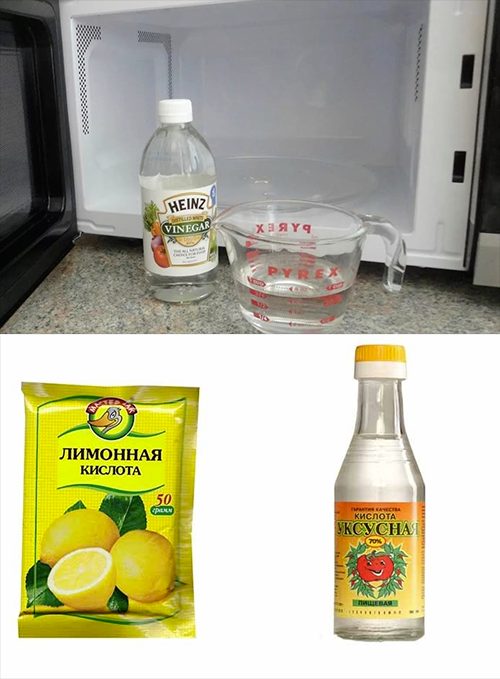
- If the impurities are not completely refilled, put the container with the remaining liquid in the oven and turn it on at maximum power. In this mode, you need to boil the liquid for several minutes (5-7);
- After that, rinse the surface with a clean cloth and wipe dry.
Method number 4 - use citrus fruits
If citric acid was not found in the house, and the smell of vinegar is too pungent for you, you can use fresh citrus fruits or even their peel.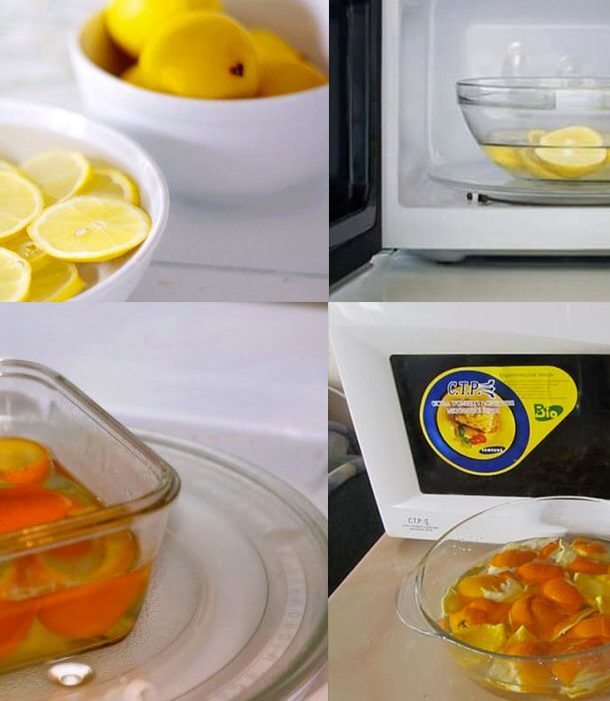
- The peel from any citrus must be put in a deep container and pour hot water;
- Place the container in the microwave and turn on the device for 5-10 minutes at maximum temperature;
- During the boiling of water from the peel, ether components will begin to stand out, which together with the steam will settle on the walls of the furnace;
- The acidified composition will soften the grease stains, after which you can easily remove their remains with a clean damp sponge;
- If fresh lemon is used, it must be cut lengthwise into 4 slices, squeezed juice, pour water, put squeezed slices into a container and bring to a boil in a microwave oven;
- If the dirt is quite persistent, before you turn on the oven, you can wipe some places with a piece of lemon, this will help to more likely break down the fat;
- Important - after boiling, leave the oven closed for 20-30 minutes.
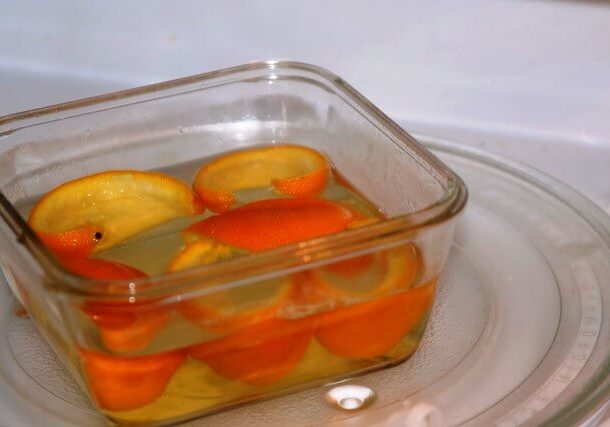 Citrus essential substances not only easily remove soap and grease stains, but also disinfect the surface and eliminate mold and bacteria. In addition, a pleasant aroma of freshness instantly spreads throughout the room.
Citrus essential substances not only easily remove soap and grease stains, but also disinfect the surface and eliminate mold and bacteria. In addition, a pleasant aroma of freshness instantly spreads throughout the room.
Method number 5 - soap solution
Soap solution will help restore purity even heavily contaminated surface.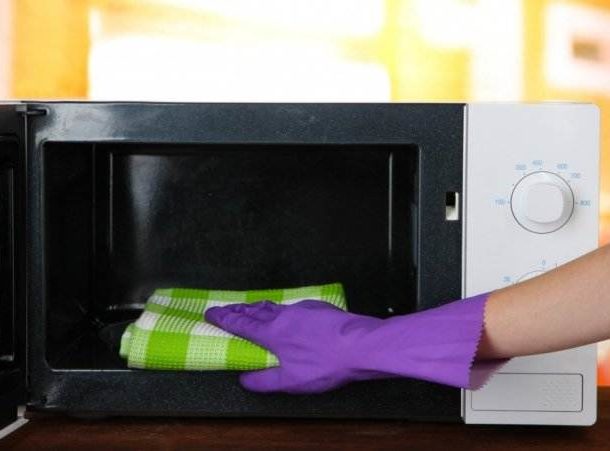
- In a container of water, add a small amount of any dishwashing detergent, stir and place in the oven;
- After the liquid boils, detect for 5-7 minutes, then turn off the microwave;
- After 15-20 minutes, open the door and rub the walls thoroughly with a soft, damp sponge.
A soapy steam bath should act more efficiently than just steam and easily dissolve any impurities.
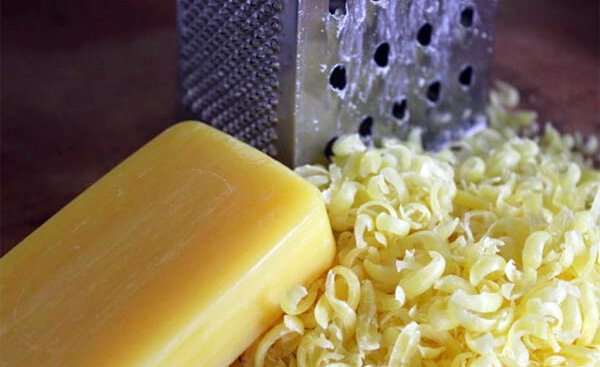 Some housewives trust more laundry soap.
Some housewives trust more laundry soap.
- A small piece of soap is rubbed on a fine grater and poured with a small amount of boiling water;
- After dissolving the soap flakes, the obtained slurry with the help of a sponge is evenly distributed on the contaminated surface and left to act for a couple of hours;
- Then it is washed off with a clean sponge, and then wiped dry;
- You can use not slurry, but a thick soapy foam.
Method number 6 - household chemicals
If none of the “popular” methods of eliminating pollution has helped, you will have to resort to household chemicals.  The most common means are:
The most common means are:
"Mister Muscle"
- Apply a sufficient amount of the product on a clean, dry sponge and evenly distribute it on the inner walls;
- Turn on the microwave at maximum power for 1 minute;
- Rinse thoroughly with dissolved contaminants with a clean damp sponge, wipe dry;
- Some recommend spraying the composition directly onto the walls, but this is not recommended. Through the holes of the grill, the composition can get on the internal elements of the device. In addition, it will not be possible to wash it off from there and each subsequent switching on of the device may be accompanied by a chemical smell, the spare part may fail.
Fairy
If pollution is not too persistent dishwashing detergent can be used.
- Apply a small amount of Fairy to a clean, dry sponge;
Put a sponge on a saucer and put in the microwave; - Turn on the device at medium power for 20-30 seconds;
- Be sure to watch so that the sponge does not start to melt;
- After time, open the door and rinse the walls with a clean cloth moistened with warm water.
Microwave Tools
There are a large number of detergents on sale specifically designed for washing microwaves. If you do not trust folk remedies or do not want to spend time on it, just choose a tool that is compatible with the material of the internal coating of your stove. Typically, the compositions have a pasty or gel-like consistency and do not scratch the surface.
Also have cleaning wipes impregnated with a special composition that successfully eliminate various types of pollution.
How to eliminate an unpleasant odor?
It often happens that the inner walls of the microwave are clean, but a characteristic unpleasant odor forms inside the device.  This happens if the cleaning is done, but not regularly, or if the food often burns. In this situation, it will not be enough to thoroughly rinse the walls with one of the above means, additional measures must be taken:
This happens if the cleaning is done, but not regularly, or if the food often burns. In this situation, it will not be enough to thoroughly rinse the walls with one of the above means, additional measures must be taken:
- Herbs will help eliminate the smell. with a steady aroma. Dried mint, lemon balm, or thyme will do. Pour a pinch of dried grass into a deep plate, pour 1 cup of water, turn on the microwave at full power for several minutes. It is necessary that the liquid in the plate boils. After that, turn off the appliance and leave the door closed for about 1 hour. At the end, thoroughly wipe the walls with a dry cloth and leave the door open for 30 minutes;
- Using the same principle, odor can be removed with lemon or orange crusts or whole slices of citrus. Only in this case, it is recommended to boil the liquid for 5-10 minutes, depending on the intensity of the odor;

- Lemon, tangerine or orange peels can not be boiled in water, but simply dried in the microwave. To do this, put the crusts on the saucer and turn on the oven for a maximum of 1-2 minutes;
- After thoroughly washing the inside walls and wiping the microwave oven dry, you can put a dish with whole coffee beans ground coffee, ordinary food salt activated carbon or curry. You do not need to turn on the oven. Just close the door and leave the selected ingredient overnight;
- Instead of grains, you can use ground coffee. Pour a tablespoon of coffee with a small amount of boiling water, wait 5 minutes, until the coffee is brewed. When after a few minutes, moisten a strong sponge and apply on the walls of the oven. After a few hours, wipe with a clean cloth and then wipe dry.
Detergent selection rules
It is very important when trying to return the microwave oven to its original clean appearance, not to disrupt the operation of the device.  Few people, when selecting the most effective detergent, pay attention to the material used to make the inner walls, and even more so to the recommendations that are prescribed in each instruction manual. Production material directly affects the ability to apply a particular tool no harm to your equipment:
Few people, when selecting the most effective detergent, pay attention to the material used to make the inner walls, and even more so to the recommendations that are prescribed in each instruction manual. Production material directly affects the ability to apply a particular tool no harm to your equipment:
- The most common coating that is often found in inexpensive microwave ovens is enameled. If cleaning is done on time, removing dirt from smooth surfaces will not be difficult. If a moment is missed, never use hard abrasive compounds and hard sponges. Also, the enameled surface may lose its original hardness and strength when regularly exposed to hot steam. Therefore, the steam cleaning method, although it is the most harmless and simple, is not recommended to be used on a regular basis. In addition, try to avoid dropping and drying drops of water and other liquid on the base, otherwise rust may form in their place;
- Pretty common is stainless coating. We can say that this is the most whimsical material in terms of cleaning. Any greasy and other contaminants will be instantly absorbed into such a surface, and become difficult to remove literally right away. In no case is it recommended to clean stainless steel with acid-added compounds and abrasive products. The spots, of course, will disappear, and with them the original shine. It is recommended to use the steam cleaning method or special, ready-made detergents specifically designed for washing stainless steel surfaces. You can also use laundry soap and solutions based on dishwashing detergents;
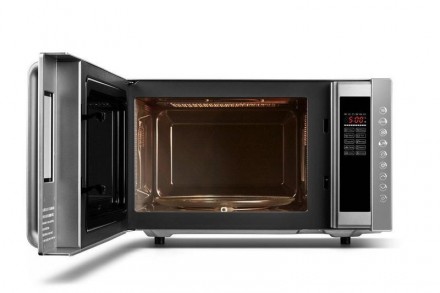
- The simplest and most unpretentious coating is ceramic. Any of the above methods can be safely used to clean such surfaces. Abrasives are strictly prohibited.
Pollution prevention
Keeping a microwave oven clean daily is much easier than trying to wash old grease stains later on.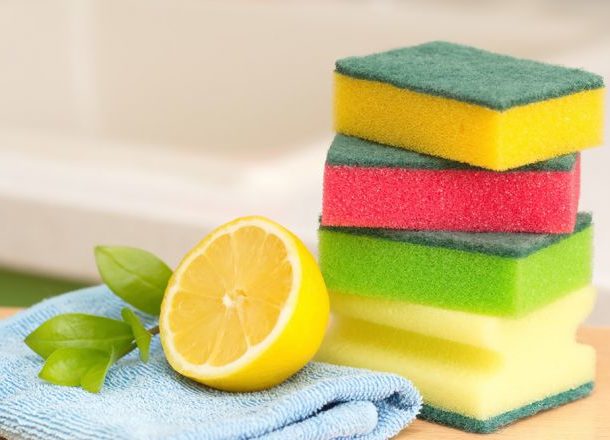 Some simple recommendations help you keep your microwave in perfect order with little effort:
Some simple recommendations help you keep your microwave in perfect order with little effort:
- Any food should be heated by covering the dish with a special lid made of heat-resistant plastic. All that you will need to do later is to wipe the glass dish with a dry cloth, as condensation may remain on it and wash the lid itself;
- If you are heating first dishes or any other liquid in the oven, make sure that its level does not reach the very edges of the dishes. When boiling, the liquid can splash over the edge and leave splashes on the walls and the rotating dish;

- Wipe off any stains or sprays immediately after using the oven. In this case, in most cases, it is enough to do just a damp sponge or slightly moistened with soap and water, and then wipe the device dry;
- After use, leave the microwave door open for a while. This will help avoid unpleasant odors in the inner chamber;
- When heating or cooking foods such as sausages, sausages or others with a film, be sure to puncture the skin with a fork in some places. Then the product will not “shoot” and leave spray on the entire inner surface;
- Be sure to immediately clean the pan of crumbs, otherwise when you reuse the oven, they will burn, and leave an unpleasant odor;
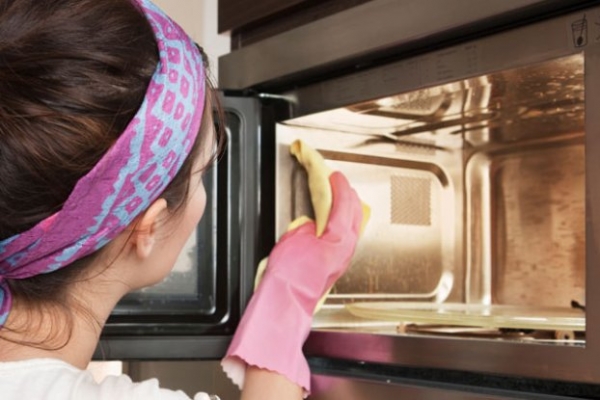
- If the microwave oven is installed in close proximity to a gas or electric stove or the sink (which, in principle, is not recommended by specialists), oily splashes or traces of soapy droplets may also remain on its outer surface. Eliminating them is also recommended immediately. If the door of the plate is made of tinted glass, first wipe it with a sponge dipped in warm water, then spray the glass cleaner and wipe it with a soft, dry cloth. The stainless surface is easily cleaned with a soapy sponge. To eliminate streaks, wipe the surface with a clean, damp cloth and then dry.

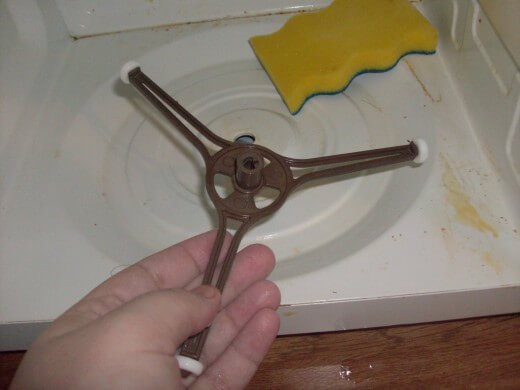
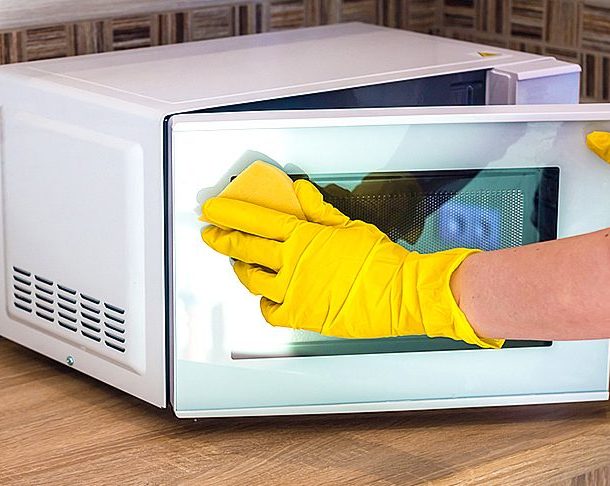

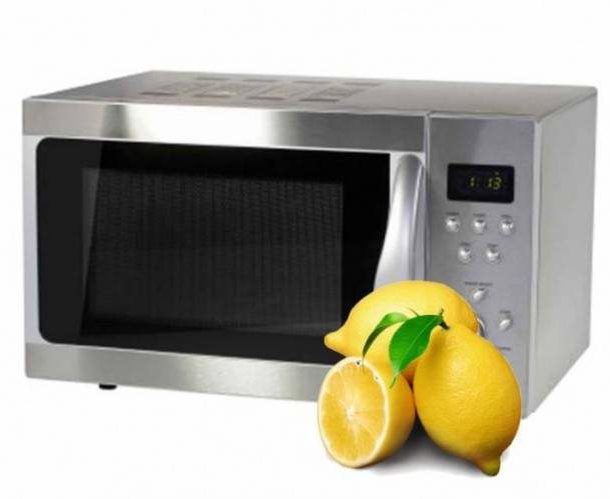
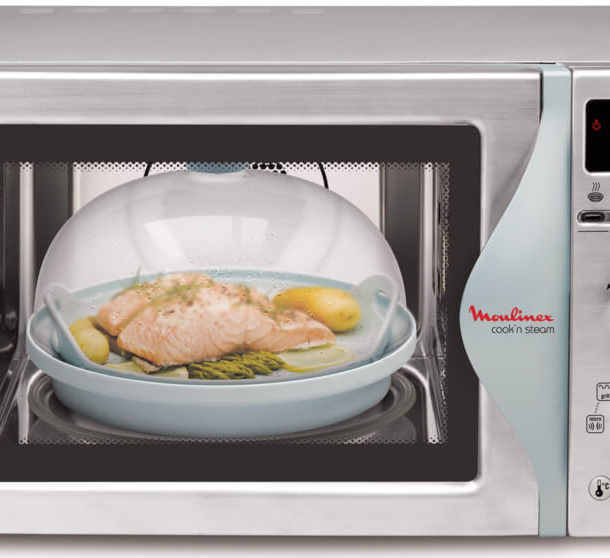


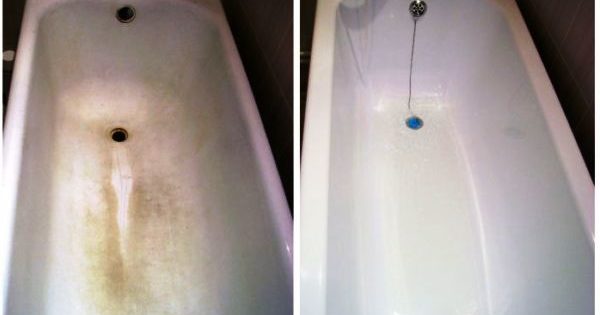
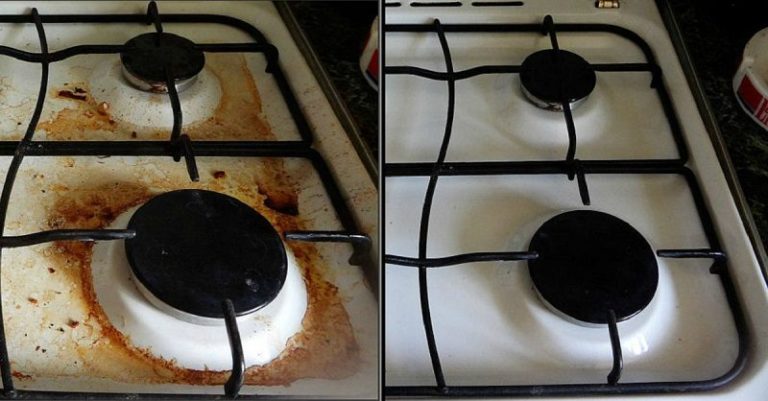



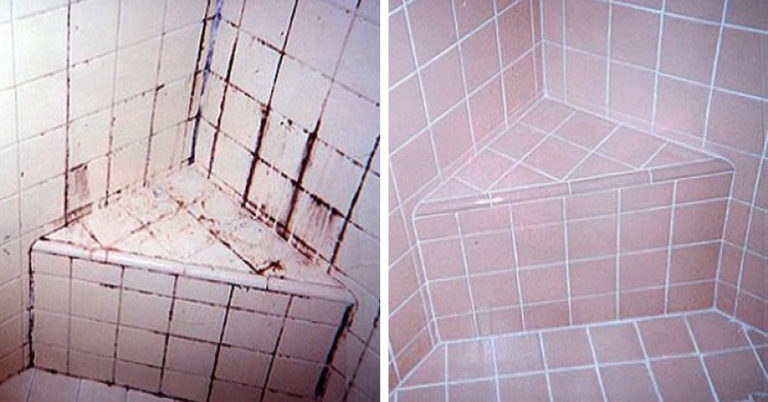
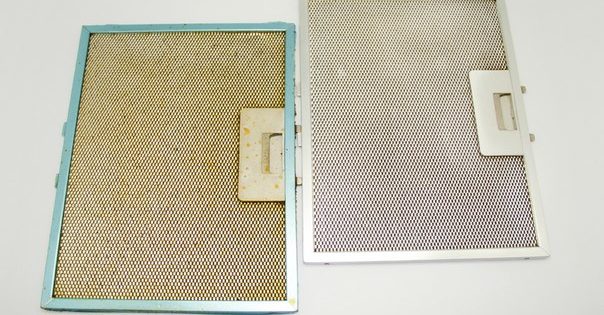

Good advice! Thanks.